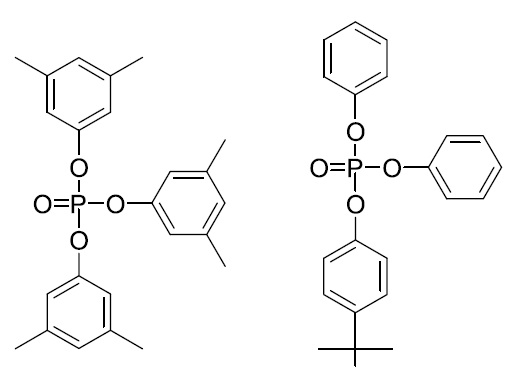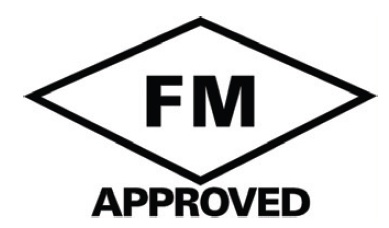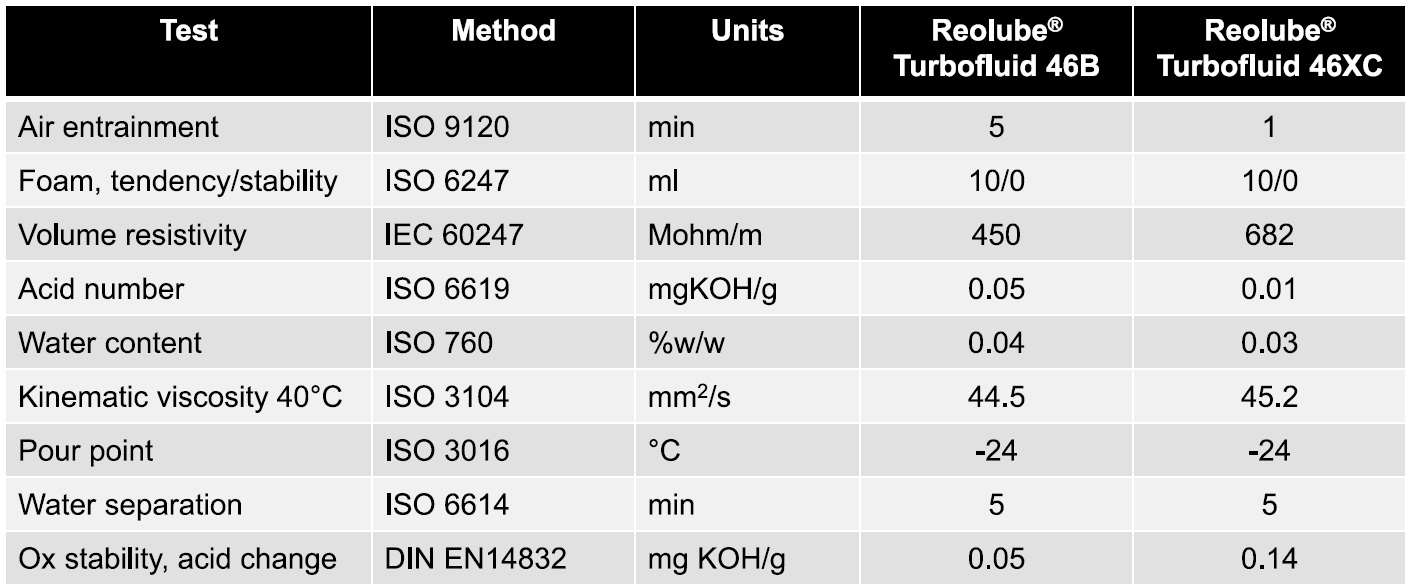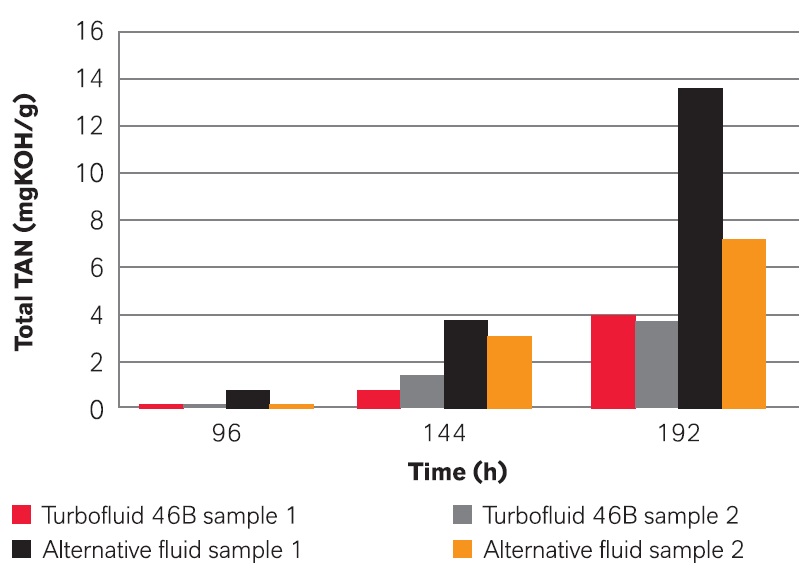LANXESS
Introducing a Hydrolytically Stable, Low Toxicity Fire-Resistant Hydraulic Fluid for Power Stations
By Mary Moon, Presque Isle Innovations, LLC | TLT CMF Plus November 2018
Truly fire-resistant fluids can prevent the accidental loss of many lives each year and significantly reduce damage, unscheduled downtime and unexpected costs associated with fires at electric power stations worldwide.
The culprit is steam. 90% of electric power worldwide is generated by steam turbines – giant versions of jet aircraft engines – whose blades rotate under the force of pressurized steam. Efficiency or the amount of electricity produced per unit of fuel depends on the temperature of the steam. The hotter, the better. That is, until a droplet of lubricant escapes through a pinhole in a pressurized line and atomizes into a mist-like spray. If tiny microdroplets land on steam pipes or other hot surfaces, a catastrophic fire can develop. This scenario caused an estimated 350 fires in power plants between 1991 and 2005.
Phosphate ester-based lubricants help prevent this scenario. These fluids have the best possible resistance to ignition and combustion. They tend not to catch on fire because they have high ignition temperatures, resist reactions with oxygen and have very low vapor pressures. If phosphate esters ignite under extreme conditions, they have the unique ability to self-extinguish because their heat of combustion is exceptionally low. Phosphate esters are the preferred choice for lubricant applications with high risk of fire.
LANXESS Reolube® Turbofluids
LANXESS (Cologne, Germany) is a leading global supplier of phosphate esters. The Lubricant Additives Business supplies more than 660 synthetic base fluids, additives and fully-formulated lubricants to over 800 customers. Phosphate esters are manufactured at a dedicated facility in Manchester, Great Britain with over 75 years of experience and distributed from regional stock points in the Americas and Asia. LANXESS is the leading global supplier of organic phosphorus derivatives for various applications.
According to David Stonecipher, Director of Business Development, Lubricant Additives Business, LANXESS Solutions US Inc., “LANXESS offers their customers a choice of Reolube® Turbofluid 46XC formulated from TXP (trixylylphosphate) and Turbofluid 46B based on TBPP (t-butylated triphenylphosphate), which provides comparable performance with lower toxicity, biodegradability and safer handling. Turbofluid 46XC and 46B are truly fire-resistant hydraulic fluids for electrohydraulic control (EHC) systems, compressors, pumps and generators at power stations. They also have excellent lubrication properties and thermal, oxidative and hydrolytic stability.” (
Figure 1)
 Figure 1. Reolube® Turbofluid phosphate ester base stock chemistries TXP (trixylylphosphate, left) and TBPP (t-butylated triphenylphosphate, right)
Figure 1. Reolube® Turbofluid phosphate ester base stock chemistries TXP (trixylylphosphate, left) and TBPP (t-butylated triphenylphosphate, right)
Fluids formulated with polyol ester, polyalkylene glycol (PAG) and phosphate ester base stocks have received FM Global Standard 6930 approval and are promoted as being fire resistant. FM Global, a property insurance company, develops its own engineering standards to evaluate (and help organizations reduce) risks for catastrophic losses. Their Approval Standard 6930, Flammable Classification of Industrial Fluids, evaluates the ignitability characteristics of a fluid in terms of its Spray Flammability Parameter or SFP. The SFP is calculated from laboratory data for the rate at which a sample releases heat when sprayed through a ring burner and the ability of its vapors to sustain ignition. However, as discussed below, not all FM Global-approved fluids are created equal. (
Figure 2)
 Figure 2. The FM insignia appears on labels of FM Global Group-approved fluids.
Figure 2. The FM insignia appears on labels of FM Global Group-approved fluids.
Turbofluids from LANXESS meet or exceed multiple standards/specifications for fire-resistant fluids because they have exceptionally high ignition temperatures and unique self-extinguishing properties:
•
FM Global Standard 6930 Approved
•
ISO 12922 for fire-resistant hydraulic fluids
•
ISO 10050 and ASTM D4293 for phosphate ester fluids in power station EHC applications
•
OEM approvals from General Electric, Siemens, Alstom, Mitsubishi, Chinese National, etc.
Fire-Resistance Comparisons
LANXESS compared the performance of Turbofluid 46B and 46XC with four other base stocks in three laboratory tests from specifications for fire-resistant EHC fluids. Only Turbofluid 46B and 46XC passed all three tests of ignition and combustion resistance. (
Figure 3)
 Figure 3. EHC fluid fire resistance tests
Figure 3. EHC fluid fire resistance tests
First, in the ISO 20830 Hot Manifold Ignition Test, a sample drops vertically onto a heated tube. The test is repeated at higher tube temperatures until ignition occurs, and the fluid may burn as it drips and collects in a tray. (
Figure 4)
 Figure 4. Reolube® Turbofluid 46XC phosphate ester fluid does not ignite below 700°C (left) while PAG ignites at approximately 450°C (right).
Figure 4. Reolube® Turbofluid 46XC phosphate ester fluid does not ignite below 700°C (left) while PAG ignites at approximately 450°C (right).
© LANXESS
The ignition temperatures of 46B and 46XC (726 and 741°C, respectively) were more than 200°C higher than for polyol ester, PAG, PAO/ester blend and Group I mineral oil. Both phosphate esters surpassed 700°C (a typical specification limit) without igniting, a critical threshold because steam temperatures can range from 300 to 600°C in power plants. All samples except 46B and 46XC burned while dripping off the tube and in the tray. These results clearly differentiated phosphate esters from other less fire-resistant fluids. (
Figure 5)
 Figure 5. Phosphate esters are the most difficult to burn in the Hot Manifold Ignition Test.
Figure 5. Phosphate esters are the most difficult to burn in the Hot Manifold Ignition Test.
Second, the ISO 14935 Wick Flame Persistence Test involves soaking a non-flammable board in test fluid. A flame is applied to an exposed edge of the board. The persistence time is measured after the flame is removed and the board continues to burn. Six trials are performed and averaged for five periods of flame application (2, 5, 10, 20 and 30 s).
Turbofluids 46B and 46XC passed the Wick Flame Persistence Test with average persistence times < 3 s while all other fluids failed to meet the 60 s maximum burn time requirement. Thanks to the self-extinguishing property of these two phosphate esters, combustion ceased 1.2 and 2.2 s after a flame was applied for 30 s to boards immersed in 46B and 46XC, respectively. (
Figure 6)
 Figure 6. Phosphate esters are the only fluids able to pass the Wick Flame Persistence Test.
Figure 6. Phosphate esters are the only fluids able to pass the Wick Flame Persistence Test.
Third, the ISO 15029-1 Spray Ignition Flame Persistence Test entails pressurizing, heating and atomizing fluid through a nozzle. The spray is ignited with a test flame at a series of positions along the spray pattern. After the spray ignites, the test flame is removed, and the persistence time is measured while the sample burns.
Typical specifications require that the sample flame extinguish within 30 s. Self-extinguishing phosphate esters 46B and 46XC were the only fluids that passed the Spray Ignition Flame Persistence Test. Maximum burn times were 2 and 8 s for 46XC and 46B, respectively. (
Figure 7)
 Figure 7. Only self-extinguishing phosphate esters pass the Spray Ignition Flame Persistence Test.
Properties of 46B and 46XC
Figure 7. Only self-extinguishing phosphate esters pass the Spray Ignition Flame Persistence Test.
Properties of 46B and 46XC
LANXESS optimized Reolube® Turbofluids 46B and 46XC (ISO VG 46) for hydraulic fluid applications. Low values for air entrainment and foam formation/stability prevent erratic operation of servo valves and cavitation of pumps. Relatively high volume resistivity avoids electrokinetic erosion of servo valve metering edges. (
Figure 8)
 Figure 8. Reolube® Turbofluid 46B and 46XC properties are optimum for hydraulic fluid applications.
Figure 8. Reolube® Turbofluid 46B and 46XC properties are optimum for hydraulic fluid applications.
Water content is low to minimize hydrolysis, i.e., reversal of reactions between acids and alcohols used to synthesize esters. Acid numbers are low to enhance stability and service life and control risk of corrosion.
Low pour point facilitates storage and use at low temperatures. Water separation facilitates removal of water contamination from in-service fluids. And oxidation stability limits production of acid from chemical reactions with oxygen known to reduce lubricity and produce precursors to varnish and sludge that can interfere with operation of servo valves and other devices.
Turbofluid 46XC has been a state of the art product for decades. However, based on new research, TXP base fluid was classified as a reproductive toxin. LANXESS invested in the development of a new product, 46B, with premium performance characteristics identical to those of 46XC. LANXESS expects that EU REACH might ban use of TXP-based fluids sometime in the near future. Turbofluid 46B provides an excellent low-toxicity alternative to 46XC.
TBPP and 46B (but not TXP and 46XC) are biodegradable, i.e., broken down readily by naturally-occurring microbes in soil and water. Biodegradable lubricants may be preferred or required for applications near bodies of water and other environmentally sensitive locations. Lubricant biodegradability is unrelated to hydrolytic, oxidative or thermal stability in applications.
Hydrolytic Stability
Hydrolytic stability, the tendency not to undergo hydrolysis reactions with water, is key to long service life of EHC fluids for power generation applications. LANXESS used the standard test DIN 14833 Determination of the Hydrolytic Stability of Fire-resistant Phosphate Ester Fluids to compare Reolube® Turbofluid 46B with a commercial TBPP-based EHC fluid from another supplier. This procedure entails heating a 300 g sample with 100 g water at 85°C. Samples are collected after 96 h; LANXESS additionally collected samples after 144 and 192 h. The TAN (total acid number) is measured to evaluate the acidity of each sample. Samples from two batches of each product were tested.
Reolube® Turbofluid 46B exhibited superior hydrolytic stability compared to the competitive product. Both samples of 46B satisfied the ISO 10050 limit (0.5 mg KOH/g sample after 96 h); only one of the two batches of competitive product met this challenge. (
Figure 9)
 Figure 9. Reolube® Turbofluid 46B exhibits superior hydrolytic stability compared to an alternative fluid.
Figure 9. Reolube® Turbofluid 46B exhibits superior hydrolytic stability compared to an alternative fluid.
The superiority of 46B became obvious after 144 h; TAN values for the competitive product were more than double those for 46B. After 192 h, the average TAN for 46B was 175% lower than for the alternative product.
According to Dana Kupenova, Global Product Manager for Phosphate Esters, Lubricant Additives Business, LANXESS Switzerland GmbH, “Many power plants, especially nuclear, are hesitant to change from one EHC fluid to another, due to many risks involved. However, EHC fluids supplied by LANXESS to the power generation industry have decades of positive user experience and a proven record of exceptional quality and longevity. For example, a satisfied customer at a nuclear power plant in the US replaced their hydraulic fluid with 600 gallons of Turbofluid 46B in EHCs for two General Electric steam turbines, each 986 MW gross. Ten years later, that Turbofluid 46B is still providing satisfactory performance.”
LANXESS Reolube® Turbofluids are sold under standard sales specifications and under LANXESS standard terms and conditions of sale. Specific recommended usage, safety and health guidelines are available from LANXESS.